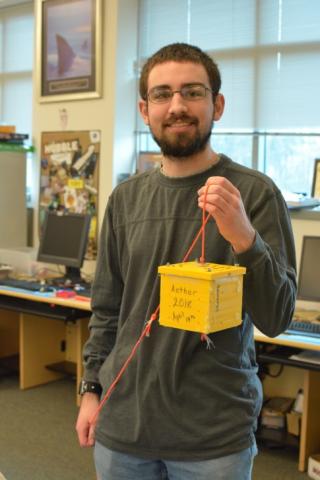www.CapTechU.edu

Project Aether brings together the talents and expertise of young astronautical engineers, computer scientists, and business students in a mission with multiple science objectives. It is the latest in a series of student-led projects initiated at Capitol, where opportunities for hands-on training are a key component of the school’s educational approach.
This past spring, the Project Aether team traveled to the Maryland-Pennsylvania border and tested their handiwork during a two-and-half hour balloon flight. Just a few weeks later, the project successfully passed an integrated subsystems testing review.
“We proved the viability of our power boards, software, and secondary science payload,’ says Sam Lawson, the project’s CAD designer. “Everything is working well.”
The team’s ultimate goal is send their payload into space in order to observe the effects of the Aurora Borealis on the atmosphere, while also testing the performance of a new insulation system and compare data rates from multiple sources.
Their mission already has racked up a notable achievement: it was selected for the prestigious RockSat-XN program in Norway. After it passes rigorous design reviews and requirements, Aether will travel into space aboard a sounding rocket.
“We have three science objectives that we aim to complete,” said Sophia LoSchiavo, who is co-leading the team together with Marissa Jagarnath. “We’ll be analyzing the composition of the atmosphere, since there’s a chance the rocket will fly through the Northern Lights. We’ll be comparing the data we receive to known data gathered from other flights. Our second goal is to compare the functionality of a hybrid insulation method, which we will modify, to standard multi-layer insulation.”
“Our third goal is to compare data rates from the Iridium satellite constellation to those of the rocket itself,” she said.
In addition to Lawson, LoSchiavo and Jagarnath, the Project Aether team includes Christopher Murray, Erik Schroen, Pierce Smith, and Dean Zinetti.
Capitol is one of a small group of schools around the United States, including Penn State and the University of New Hampshire, that will be participating in the Norway program together with international counterparts. The Capitol team is collaborating with students from nearby University of Maryland Baltimore County, and the Maryland Space Grant Consortium has provided funds needed to secure a berth on the sounding rocket.
As with all space engineering projects at Capitol, Aether adheres to a methodology dubbed Crawl, Walk, Run, Fly, designed to help teams stay on schedule and meet all project requirements, including funding, paperwork, and successful testing.
Students begin by fleshing out their ideas in the form of a mission statement and defined goals and objectives. They create concepts and prototypes, then begin a series of high-altitude balloon tests, in preparation for a sounding rocket launch. For many missions, the eventual goal is to secure space on an orbiting satellite.
No comments:
Post a Comment